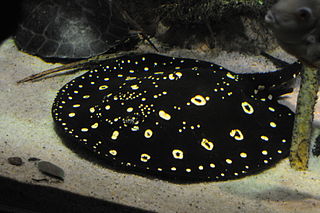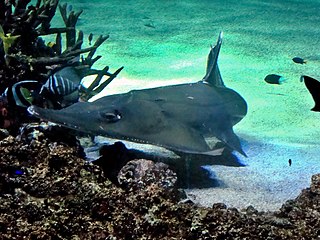
River stingrays or freshwater stingrays are Neotropical freshwater fishes of the family Potamotrygonidae in the order Myliobatiformes, one of the four orders of batoids, cartilaginous fishes related to sharks. They are found in rivers in tropical and subtropical South America. A single marine genus, Styracura, of the tropical West Atlantic and East Pacific are also part of Potamotrygonidae. They are generally brownish, greyish or black, often with a mottled, speckled or spotted pattern, have disc widths ranging from 31 to 200 centimetres (1.0–6.6 ft) and venomous tail stingers. River stingrays feed on a wide range of smaller animals and the females give birth to live young. There are more than 35 species in five genera.

Dipturus is a large genus of skates native to the Pacific, Atlantic, and Indian Oceans. They were formerly included in Raja. Some species initially moved to Dipturus were later placed in Dentiraja, Spiniraja, and Zearaja.

The barndoor skate is a species of marine cartilaginous fish in the skate family Rajidae of the order Rajiformes. It is native to the northwestern Atlantic Ocean, and is found from the Grand Banks of Newfoundland and the southern side of the Gulf of St. Lawrence south to North Carolina. The fish is one of the largest skates found in the North Atlantic Ocean, reaching lengths up to 1.5 m (5 ft). It is carnivorous, feeding on invertebrates and other fish found near the sea floor.

Rhina ancylostoma, the bowmouth guitarfish, shark ray or mud skate, is a species of ray and a member of the family Rhinidae. Its evolutionary affinities are not fully resolved, though it may be related to true guitarfishes and skates. This rare species occurs widely in the tropical coastal waters of the western Indo-Pacific, at depths of up to 90 m (300 ft). Highly distinctive in appearance, Rhina ancylostoma has a wide and thick body with a rounded snout and large shark-like dorsal and tail fins. Its mouth forms a W-shaped undulating line, and there are multiple thorny ridges over its head and back. It has a dorsal color pattern of many white spots over a bluish gray to brown background, with a pair of prominent black markings over the pectoral fins. This large species can reach a length of 2.7 m (8.9 ft) and weight of 135 kg (298 lb).

The giant guitarfish, also known as the whitespotted wedgefish, is a large species of guitarfish in the family Rhinidae. It is restricted to the Red Sea, Persian Gulf, and western Indian Ocean, but was formerly considered more widespread due to confusion with its relatives.
The shortlip electric ray, is a species of electric ray in the numbfish family, Narcinidae. It may be synonymous with the blackspotted numbfish, Narcine maculata. The shortlip electric ray is found in shallow continental shelf waters offshore of China, Malaysia, Thailand, and Vietnam, at a depth of 41 to 70 meters. It is assessed as Vulnerable on the IUCN Red List, as it is caught as by-catch in large numbers by shrimp trawling fisheries operating throughout its range.

The bigtooth river stingray or Tocantins River ray is a species of freshwater fish in the family Potamotrygonidae. It is endemic to the lower Tocantins basin and Araguaia basin in Brazil, and prefers muddy bottoms. It is sometimes kept in aquaria. This stingray is generally common and its population increased after the Tucuruí Dam was completed, unlike many other species in its range.

Rhynchobatus australiae, also called the white-spotted guitarfish, white-spotted wedgefish or bottlenose wedgefish, is a species of fish in the Rhinidae family. It is found from shallow waters to a depth of at least 60 m (200 ft) in the Indo-Pacific, ranging from the East African coast and the Red Sea, to Taiwan, the Philippines and Australia. It is part of a species complex that also includes the giant guitarfish, the broadnose wedgefish and possibly the smoothnose wedgefish.

Rhynchobatus is a group of rays commonly known as wedgefishes in the family Rhinidae. They are found in the tropical and subtropical Indo-Pacific with a single species in the eastern Atlantic. All species in this genus are assessed as Vulnerable or Endangered by IUCN.

The African wedgefish, guitarra, Lubbert's guitarfish, or spikenose wedgefish is a species of fish in the Rhinidae family. It is the only species in its genus to occur in the East Atlantic.
The roughnose wedgefish is a species of fish in the Rhinidae family. It is found in Indonesia and Singapore. Its natural habitats are open seas, shallow seas, coral reefs, estuarine waters, and coastal saline lagoons. It is threatened by habitat loss. Despite having been known for more than a decade, it remained undescribed until 2016. This is a relatively small species, reaching up to 81 cm (2.66 ft) in length. Adults are greenish-brown above; young have white spots.
The broadnose wedgefish is a species of fish in the Rhinidae family. It is found in coastal and estuarine habitats in southeast Asia, where documented from Java, Borneo, Singapore, the Philippines and Thailand. It is threatened by habitat loss and overfishing. This is a medium-sized species of Rhynchobatus, which reaches a maximum length of about 2.15 m (7.1 ft).

The black-spotted torpedo is a poorly known, uncommon species of electric ray in the family Torpedinidae, known for being capable of generating an electric shock. It is endemic to southern Africa and possibly several small Indian Ocean islands, although the latter reports may represent undescribed new species. Its appearance is similar to the Gulf torpedo, but it is duller in coloration.

The Gulf torpedo or variable electric ray, is a species of electric ray in the family Torpedinidae. It is found in the Indian Ocean, but may represent a species flock of several local endemic species. It is distinguishable from other Torpedo species in its range by its ornate dorsal coloration. Another common name, marbled electric ray, is not to be confused with Torpedo marmorata.

Pristiophorus is a genus of sawsharks found in the Pacific, Atlantic and Indian oceans. Members of this genus differ from the Sixgill Sawshark (Pliotrema warreni) in having five gill slits. Their rostral sawteeth lack prominent transverse ridges on the basal ledges, and the large teeth are not posteriorly serrated.

Wedgefishes are rays of the family Rhinidae, comprising eleven species in three genera. Classified in the order Rhinopristiformes along with guitarfishes and sawfishes, they have also been known as giant guitarfishes or sharkfin guitarfishes.
Rhynchobatus palpebratus, the eyebrow wedgefish, is a species of fish in the Rhinidae family. It is found in coastal waters off northern Australia. It reaches up to 2.62 m (8.6 ft) in length and closely resemble the smoothnose wedgefish, which has denser white spotting, and also differ in distribution and genetics.
The false shark ray is a species of fish in the Rhinidae family and the only species in the genus Rhynchorhina. This rare ray is only known from shallow coastal Atlantic waters in Banc d’Arguin, Mauritania.
Rhynchobatus immaculatus, the Taiwanese wedgefish, is a species of fish in the family Rhinidae. It is found in the Pacific Ocean in the vicinity of Taiwan. This species reaches a length of 99 cm (39 in).











